Huiming Wang
SWE-Compass: Towards Unified Evaluation of Agentic Coding Abilities for Large Language Models
Nov 07, 2025Abstract:Evaluating large language models (LLMs) for software engineering has been limited by narrow task coverage, language bias, and insufficient alignment with real-world developer workflows. Existing benchmarks often focus on algorithmic problems or Python-centric bug fixing, leaving critical dimensions of software engineering underexplored. To address these gaps, we introduce SWE-Compass1, a comprehensive benchmark that unifies heterogeneous code-related evaluations into a structured and production-aligned framework. SWE-Compass spans 8 task types, 8 programming scenarios, and 10 programming languages, with 2000 high-quality instances curated from authentic GitHub pull requests and refined through systematic filtering and validation. We benchmark ten state-of-the-art LLMs under two agentic frameworks, SWE-Agent and Claude Code, revealing a clear hierarchy of difficulty across task types, languages, and scenarios. Moreover, by aligning evaluation with real-world developer practices, SWE-Compass provides a rigorous and reproducible foundation for diagnosing and advancing agentic coding capabilities in large language models.
A Scenario-Driven Cognitive Approach to Next-Generation AI Memory
Sep 16, 2025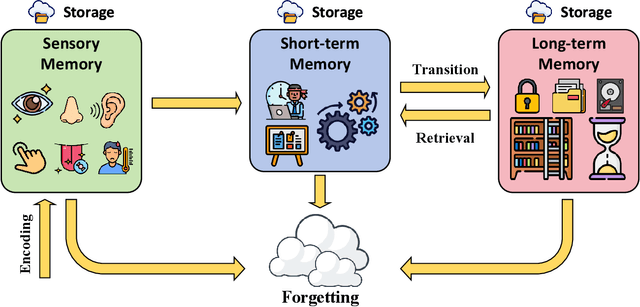
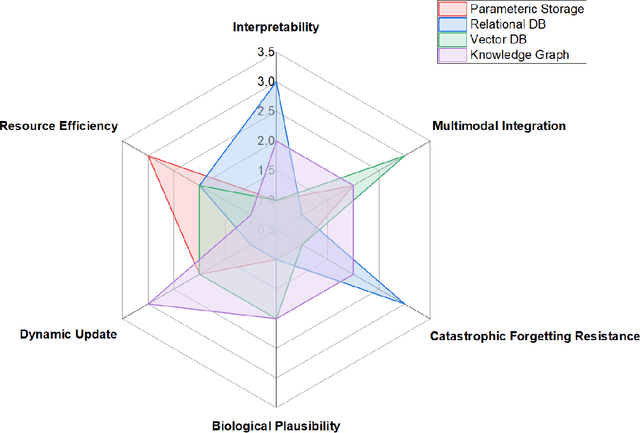
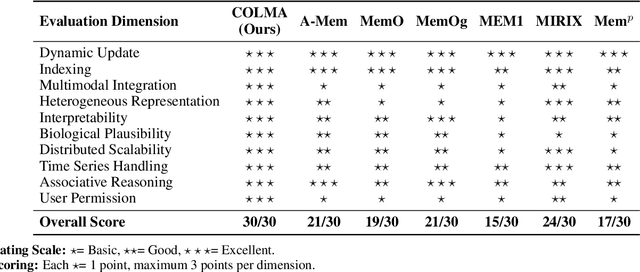

Abstract:As artificial intelligence advances toward artificial general intelligence (AGI), the need for robust and human-like memory systems has become increasingly evident. Current memory architectures often suffer from limited adaptability, insufficient multimodal integration, and an inability to support continuous learning. To address these limitations, we propose a scenario-driven methodology that extracts essential functional requirements from representative cognitive scenarios, leading to a unified set of design principles for next-generation AI memory systems. Based on this approach, we introduce the \textbf{COgnitive Layered Memory Architecture (COLMA)}, a novel framework that integrates cognitive scenarios, memory processes, and storage mechanisms into a cohesive design. COLMA provides a structured foundation for developing AI systems capable of lifelong learning and human-like reasoning, thereby contributing to the pragmatic development of AGI.
CLaSp: In-Context Layer Skip for Self-Speculative Decoding
May 30, 2025Abstract:Speculative decoding (SD) is a promising method for accelerating the decoding process of Large Language Models (LLMs). The efficiency of SD primarily hinges on the consistency between the draft model and the verify model. However, existing drafting approaches typically require additional modules to be trained, which can be challenging to implement and ensure compatibility across various LLMs. In this paper, we propose CLaSp, an in-context layer-skipping strategy for self-speculative decoding. Unlike prior methods, CLaSp does not require additional drafting modules or extra training. Instead, it employs a plug-and-play mechanism by skipping intermediate layers of the verify model to construct a compressed draft model. Specifically, we develop a dynamic programming algorithm that optimizes the layer-skipping process by leveraging the complete hidden states from the last verification stage as an objective. This enables CLaSp to dynamically adjust its layer-skipping strategy after each verification stage, without relying on pre-optimized sets of skipped layers. Experimental results across diverse downstream tasks demonstrate that CLaSp achieves a speedup of 1.3x ~ 1.7x on LLaMA3 series models without altering the original distribution of the generated text.
LLM-R2: A Large Language Model Enhanced Rule-based Rewrite System for Boosting Query Efficiency
Apr 19, 2024Abstract:Query rewrite, which aims to generate more efficient queries by altering a SQL query's structure without changing the query result, has been an important research problem. In order to maintain equivalence between the rewritten query and the original one during rewriting, traditional query rewrite methods always rewrite the queries following certain rewrite rules. However, some problems still remain. Firstly, existing methods of finding the optimal choice or sequence of rewrite rules are still limited and the process always costs a lot of resources. Methods involving discovering new rewrite rules typically require complicated proofs of structural logic or extensive user interactions. Secondly, current query rewrite methods usually rely highly on DBMS cost estimators which are often not accurate. In this paper, we address these problems by proposing a novel method of query rewrite named LLM-R2, adopting a large language model (LLM) to propose possible rewrite rules for a database rewrite system. To further improve the inference ability of LLM in recommending rewrite rules, we train a contrastive model by curriculum to learn query representations and select effective query demonstrations for the LLM. Experimental results have shown that our method can significantly improve the query execution efficiency and outperform the baseline methods. In addition, our method enjoys high robustness across different datasets.
AdaMergeX: Cross-Lingual Transfer with Large Language Models via Adaptive Adapter Merging
Feb 29, 2024

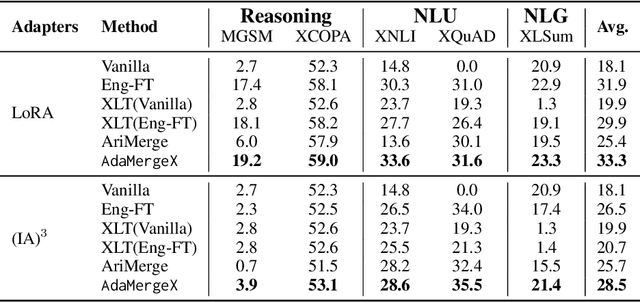
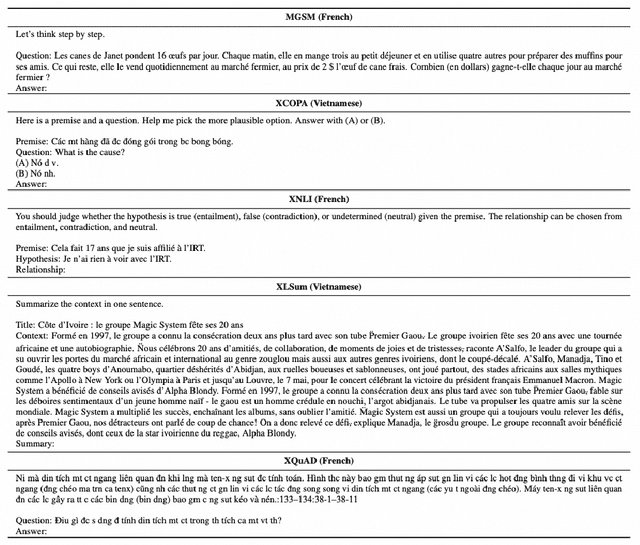
Abstract:As an effective alternative to the direct fine-tuning on target tasks in specific languages, cross-lingual transfer addresses the challenges of limited training data by decoupling ''task ability'' and ''language ability'' by fine-tuning on the target task in the source language and another selected task in the target language, respectively. However, they fail to fully separate the task ability from the source language or the language ability from the chosen task. In this paper, we acknowledge the mutual reliance between task ability and language ability and direct our attention toward the gap between the target language and the source language on tasks. As the gap removes the impact of tasks, we assume that it remains consistent across tasks. Based on this assumption, we propose a new cross-lingual transfer method called $\texttt{AdaMergeX}$ that utilizes adaptive adapter merging. By introducing a reference task, we can determine that the divergence of adapters fine-tuned on the reference task in both languages follows the same distribution as the divergence of adapters fine-tuned on the target task in both languages. Hence, we can obtain target adapters by combining the other three adapters. Furthermore, we propose a structure-adaptive adapter merging method. Our empirical results demonstrate that our approach yields new and effective cross-lingual transfer, outperforming existing methods across all settings.
Semantic-Aware Contrastive Sentence Representation Learning with Large Language Models
Oct 17, 2023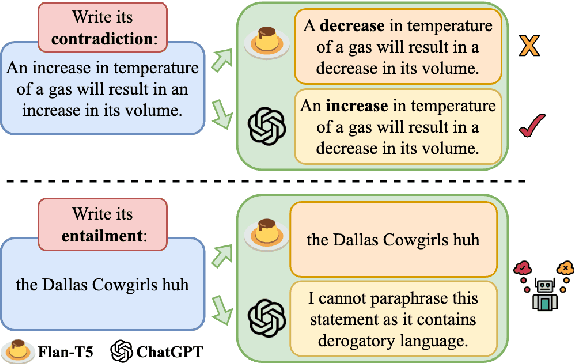
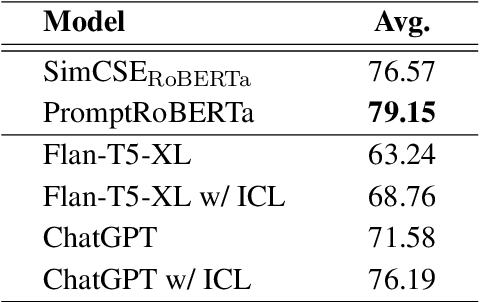
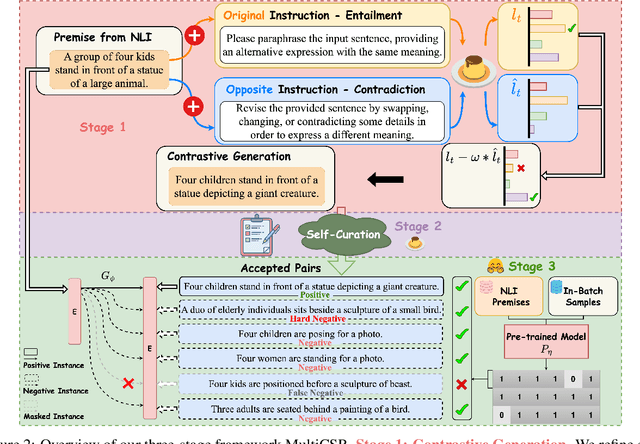

Abstract:Contrastive learning has been proven to be effective in learning better sentence representations. However, to train a contrastive learning model, large numbers of labeled sentences are required to construct positive and negative pairs explicitly, such as those in natural language inference (NLI) datasets. Unfortunately, acquiring sufficient high-quality labeled data can be both time-consuming and resource-intensive, leading researchers to focus on developing methods for learning unsupervised sentence representations. As there is no clear relationship between these unstructured randomly-sampled sentences, building positive and negative pairs over them is tricky and problematic. To tackle these challenges, in this paper, we propose SemCSR, a semantic-aware contrastive sentence representation framework. By leveraging the generation and evaluation capabilities of large language models (LLMs), we can automatically construct a high-quality NLI-style corpus without any human annotation, and further incorporate the generated sentence pairs into learning a contrastive sentence representation model. Extensive experiments and comprehensive analyses demonstrate the effectiveness of our proposed framework for learning a better sentence representation with LLMs.
Enhancing Few-shot NER with Prompt Ordering based Data Augmentation
May 19, 2023



Abstract:Recently, data augmentation (DA) methods have been proven to be effective for pre-trained language models (PLMs) in low-resource settings, including few-shot named entity recognition (NER). However, conventional NER DA methods are mostly aimed at sequence labeling models, i.e., token-level classification, and few are compatible with unified autoregressive generation frameworks, which can handle a wider range of NER tasks, such as nested NER. Furthermore, these generation frameworks have a strong assumption that the entities will appear in the target sequence with the same left-to-right order as the source sequence. In this paper, we claim that there is no need to keep this strict order, and more diversified but reasonable target entity sequences can be provided during the training stage as a novel DA method. Nevertheless, a naive mixture of augmented data can confuse the model since one source sequence will then be paired with different target sequences. Therefore, we propose a simple but effective Prompt Ordering based Data Augmentation (PODA) method to improve the training of unified autoregressive generation frameworks under few-shot NER scenarios. Experimental results on three public NER datasets and further analyses demonstrate the effectiveness of our approach.
 Add to Chrome
Add to Chrome Add to Firefox
Add to Firefox Add to Edge
Add to Edge